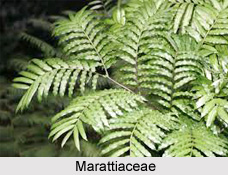 Class Marattiopsida is a group of ferns containing a single order, Marattiales, and family, Marattiaceae. Class Marattiopsida departed from other ferns very early during their evolutionary period. They differ from other plants common to people in temperate zones.
Class Marattiopsida is a group of ferns containing a single order, Marattiales, and family, Marattiaceae. Class Marattiopsida departed from other ferns very early during their evolutionary period. They differ from other plants common to people in temperate zones.
Many of them have massive, fleshy rootstocks and the largest known fronds of any fern. The Marattiaceae is one of two eusporangiate fern families known as eusporangiate fern.
The Marattiaceae has about 260 existing species and many fossil representatives. The extant members are placed in six genera: Angiopteris, Christensenia, Danaea, Eupodium, Marattia and Ptisana.
This early fern family is one of the oldest extant lineages of vascular plants that have not modified over millions of years. They have a comparatively good fossil record from the early Carboniferous (300 Ma) to the current day. They can be effortlessly distinguished from other ferns by their complex polycyclic structure. They can also be discriminated on the basis of their large, starchy rhizomes with fleshy or papery stipule-like outgrowths on each side of the petioles, presence of swollen nodes on rachises and often also on petioles, and eusporangia that are often fused and ligneous.
Marattiaceae mainly originate in tropical or subtropical forests where the temperature and air humidity remain soaring all through the year. While Angiopteris and Christensenia prefer lowland rain forest and grow in partly open habitats, Marattia are inclined to grow in high altitude cloud forest and semi-deciduous forest in the subtropics. Danaea grows mostly in closed canopy, lowland and mountain rain forest and other shady, humid places, along stream banks, in ravines, and in sinkholes or near waterfalls, quite often on rather steep slopes.
Scientific Classification of Marattiaceae
Kingdom: Plantae
Division: Pteridophyta
Class: Marattiopsida
Doweld Order: Marattiales
Link Family: Marattiaceae
Characteristics of Marattiaceae
The Marattiaceae are a separate group of terrestrial ferns characterized by large, fleshy, erect or creeping rhizomes, with a polycyclic dictyostele, and mucilage canals in the roots, rhizomes and leaves. Young plants usually have a mycorrhizal fungus - the oomycete Stigeosporium mamttiacearum C. West - within the cortex. Many species produce buds on the stipules or on the leaves.
The sporangia are usually merged in round or stretched in synangia, where a thin part of the sporangium dries and shrinks to form a pore through which the spores fall. Each sporangium includes several numbers of spores (from about 1000 in Angiopteris to 7000 in Christensenia).
The spores germinate rapidly, within a few days of being shed, and develop into large, monoecious, dark-green, mycorrhizal prothalli that can live for several years.
The young parts of Angiopteris, Ptisana, Eupodium and Marattia are covered with short simple hairs, while those of Christensenia and Danaea bear peltate scales. Microscopic characters, such as hairs, scales and indusia, which are of great taxonomic importance in other fern groups, are absent or vary little within marattioid genera. Vegetative reproduction appears to be an important way of dispersal. Simplest form of reproduction can be achieved by means of stipule cuttings. It is the easiest way of cultivation for Marattia and Angiopteris.



















